The Impact of Underground Logistics System on Urban Sustainable Development: A System Dynamics Approach
Abstract
1. Introduction
2. Literature Review
2.1. Review of the ULS
2.1.1. Research Topics
2.1.2. Cost–Benefit
2.1.3. Policy Support
2.2. A Review of System Dynamics
3. Model Development
3.1. Empirical Background Analysis
3.2. Causal Loop Diagram (CLD)
3.3. Simulation Model Formation
3.3.1. Regulator Subsystem
3.3.2. Demand Subsystem
3.3.3. ULS Subsystem
3.3.4. Performance Subsystem
4. Data and Model Testing
4.1. Output Fitting of Historical Data
4.2. Behavioral Validity of the Model
4.3. Extreme Conditions Test
5. System Simulation and Results
5.1. Implementation Strategies of ULS
5.2. Simulation Results and Analysis
6. Conclusions
Author Contributions
Funding
Conflicts of Interest
References
- Lindholm, M.; Behrends, S. Challenges in urban freight transport planning – a review in the Baltic Sea Region. J. Transp. Geogr. 2012, 22, 129–136. [Google Scholar] [CrossRef]
- Dablanc, L. Goods transport in large European cities: Difficult to organize, difficult to modernize. Transp. Res. Part A Policy Pract. 2007, 41, 280–285. [Google Scholar] [CrossRef]
- Richardson, B.C. Sustainable transport: Analysis frameworks. J. Transp. Geogr. 2005, 13, 29–39. [Google Scholar] [CrossRef]
- Vernimmen, B.; Dullaert, W.; Geens, E.; Notteboom, T.; T’Jollyn, B.; Van Gilsen, W.; Winkelmans, W. Underground logistics systems: A way to cope with growing internal container traffic in the port of antwerp? Transp. Plan. Techn. 2007, 30, 391–416. [Google Scholar] [CrossRef]
- Chen, Z.; Dong, J.; Ren, R. Urban underground logistics system in China: Opportunities or challenges? Underground Space. 2017, 2, 195–208. [Google Scholar] [CrossRef]
- Rezaeifar, F.; Najafi, M.; Ardekani, S.A.; Shahooei, S. Optimized terminal design for UFT systems in integrated subterranean pipeline infrastructure. In Proceedings of the Sessions of the Pipelines Conference, Phoenix, AZ, USA, 6–9 August 2017. [Google Scholar]
- O’Connell, R.M.; Liu, H.; Lenau, C.W. Performance of pneumatic capsule pipeline freight transport system driven by linear motor. J. Transp. Eng. 2008, 134, 50–58. [Google Scholar] [CrossRef]
- Marchau, V.; Walker, W.; Van Duin, R. An adaptive approach to implementing innovative urban transport solutions. Transp. Policy. 2008, 15, 405–412. [Google Scholar] [CrossRef]
- Tabesh, A.; Najafi, M.; Ashoori, T.; Tavakoli, R.; Shahandashti, S.M. Environmental impacts of pipeline construction for underground freight transportation. In Proceedings of the Sessions of the Pipelines Conference, Phoenix, AZ, USA, 6–9 August 2017. [Google Scholar]
- Dong, J.; Hu, W.; Yan, S.; Ren, R.; Zhao, X. Network Planning Method for Capacitated Metro-Based Underground Logistics System. Adv. Civ. Eng. 2018, 2018, 6958086. Available online: https://www.hindawi.com/journals/ace/2018/6958086/abs/ (accessed on 20 February 2019).
- Egbunike, O.N.; Potter, A.T. Are freight pipelines a pipe dream? A critical review of the UK and European perspective. J. Transp. Geogr. 2011, 19, 499–508. [Google Scholar] [CrossRef]
- Asim, T.; Mishra, R. Computational fluid dynamics based optimal design of hydraulic capsule pipelines transporting cylindrical capsules. Powder Technol. 2016, 295, 180–201. [Google Scholar] [CrossRef]
- Schmitt, M.; Wagner, G. Research on the air drag of the underground freight transportation system CargoCap. In Proceedings of the 5th International Symposium on Underground Freight Transportation by Capsule Pipelines and Other Tube/Tunnel Systems, Arlington, TX, USA, 20–22 March 2008. [Google Scholar]
- Kashima, S.; Matano, R.N.; Taguchi, M.T.; Shigenaga, T. Study of an underground physical distribution system in a high-density, built-up area. Tunn. Undergr. Space Technol. 1993, 8, 53–59. [Google Scholar] [CrossRef]
- Cotana, F.; Rossi, F.; Marri, A. Pipe§net: Application study and further development of system. In Proceedings of the 6th International Symposium on Underground Freight Transportation by Capsule Pipelines and Other Tube/Tunnel Systems, Shanghai, China, 17–18 November 2010. [Google Scholar]
- Van der Heijden, M.C.; van Harten, A.; Ebben, M.J.R.; Saanen, Y.A.; Valentin, E.C.; Verbraeck, A. Using Simulation to Design an Automated Underground System for Transporting Freight around Schiphol Airport. Interfaces 2002, 32, 1–19. [Google Scholar] [CrossRef]
- Stein, D.; Stein, R.; Beckmann, D.; Schoesser, B. CargoCap: Feasibility study of transporting containers through underground pipelines. In Proceedings of the 4th International Symposium on Underground Freight Transportation by Capsule Pipelines and Other Tube/Tunnel Systems, Shanghai, China, 20–21 October 2010. [Google Scholar]
- Liu, H.; Lenau, C.W. A LIM-PCP system for freight transportation in underground cities. In Proceedings of the 12th International Conference of the Associated Research Centers for Urban Underground Space, Shenzhen, China, 18–19 November 2009. [Google Scholar]
- Wiegmans, B.W.; Visser, J.; Konings, R.; Pielage, B.J.A. Review of underground logistic systems in the Netherlands: An ex-post evaluation of barriers, enablers and spin-offs. Eur. Transp. Trasp. Eur. 2010, 45, 34–49. [Google Scholar]
- Visser, J.; Wiegmans, B.; Konings, B. Review of underground logistic systems in the Netherlands: An ex-post evaluation of barriers, enablers and spin-off. In Proceedings of the 5th International Symposium on Underground Freight Transportation by Capsule Pipelines and Other Tube/Tunnel Systems, Arlington, TX, USA, 20–22 March 2008. [Google Scholar]
- Kosugi, S. Effect of traveling resistance factor on pneumatic capsule pipeline system. Powder Technol. 1999, 104, 227–232. [Google Scholar] [CrossRef]
- Chen, Y.; Guo, D.; Chen, Z.; Fan, Y.; Li, X. Using a multi-objective programming model to validate feasibility of an underground freight transportation system for the Yangshan port in Shanghai. Tunn. Undergr. Space Technol. 2018, 81, 463–471. [Google Scholar] [CrossRef]
- Zhang, C.; Wang, S. Comprehensive evaluation based on AHP-Fuzzy about the conception of underground container transportation lines in Shanghai. Appl. Mech. Mater. 2011, 71–78, 175–181. [Google Scholar] [CrossRef]
- Li, T.; Wang, Z. Optimization layout of underground logistics network in big cities with plant growth simulation algorithm. Syst. Eng. Theory Pract. 2013, 33, 971–980. [Google Scholar]
- Tabesh, A.; Najafi, M.; Ashoori, T.; Rezaei, N. Comparison of construction methods for underground freight transportation in Texas. In Proceedings of the Pipelines Conference—Out of Sight, Out of Mind, Not Out of Risk (Pipelines), Kansas City, MO, USA, 17–20 July 2016. [Google Scholar]
- Zahed, S.E.; Shahandashti, S.M.; Najafi, M. Lifecycle Benefit-Cost Analysis of Underground Freight Transportation Systems. J. Pipeline Syst. Eng. Pract. 2018, 9, 04018003. Available online: https://ascelibrary.org/doi/full/10.1061/%28ASCE%29PS.1949-1204.0000313 (accessed on 20 February 2019). [CrossRef]
- Bliss, D. Mail rail—70 years of automated underground freight transport. In Proceedings of the 2th International Symposium on Underground Freight Transportation by Capsule Pipelines and Other Tube/Tunnel Systems, Delft, The Netherlands, 28–29 September 2000. [Google Scholar]
- Zhao, X.; Hwang, B.G.; Yu, G.S. Identifying the critical risks in underground rail international construction joint ventures: Case study of Singapore. Int. J. Proj. Manag. 2013, 31, 554–566. [Google Scholar] [CrossRef]
- Hwang, B.G.; Zhao, X.; Yu, G.S. Risk identification and allocation in underground rail construction joint ventures: contractors’ perspective. J. Civ. Eng. Manag. 2016, 22, 758–767. [Google Scholar] [CrossRef]
- Ehsan Zahed, S.; Mohsen Shahandasht, S.; Najafi, M. Investment Valuation of an Underground Freight Transportation (UFT) System in Texas. In Proceedings of the Sessions of the Pipelines Conference, Phoenix, AZ, USA, 6–9 August 2017. [Google Scholar]
- Behiri, W.; Belmokhtar-Berraf, S.; Chu, C. Urban freight transport using passenger rail network: Scientific issues and quantitative analysis. Transp. Res. Part. E Logist. Transp. Rev. 2018, 115, 227–245. [Google Scholar] [CrossRef]
- Visser, J. The development of underground freight transport: An overview. Tunn. Undergr. Space Technol. 2018, 80, 123–127. [Google Scholar] [CrossRef]
- Chen, Z.; Chen, J.; Liu, H.; Zhang, Z. Present status and development trends of underground space in Chinese cities: Evaluation and analysis. Tunn. Undergr. Space Technol. 2018, 71, 253–270. [Google Scholar] [CrossRef]
- Thompson, B.P.; Bank, L.C. Use of system dynamics as a decision-making tool in building design and operation. Build. Environ. 2010, 45, 1006–1015. [Google Scholar] [CrossRef]
- Guan, D.; Gao, W.; Su, W.; Li, H.; Hokao, K. Modeling and dynamic assessment of urban economy-resource-environment system with a coupled system dynamics-geographic information system model. Ecol. Indicat. 2011, 11, 1333–1344. [Google Scholar] [CrossRef]
- Yao, H.; Shen, L.; Tan, Y.; Hao, J. Simulating the impacts of policy scenarios on the sustainability performance of infrastructure projects. Autom. ConStruct. 2011, 20, 1060–1069. [Google Scholar] [CrossRef]
- Armah, F.; Yawson, D.; Pappoe, A.A.N.M. A Systems Dynamics Approach to Explore Traffic Congestion and Air Pollution Link in the City of Accra, Ghana. Sustainability 2010, 2, 252–265. [Google Scholar] [CrossRef]
- Sverdrup, H.U.; Ragnarsdottir, K.V. A system dynamics model for platinum group metal supply, market price, depletion of extractable amounts, ore grade, recycling and stocks-in-use. Resour. Conserv. Recycl. 2016, 114, 130–152. [Google Scholar] [CrossRef]
- Liu, B.; Xiao, B. Exploring the development of electric vehicles under policy incentives: A scenario-based system dynamics model. Energy Policy. 2018, 120, 8–23. [Google Scholar] [CrossRef]
- Tob-Ogu, A.; Kumar, N.; Cullen, J.; Ballantyne, E. Sustainability Intervention Mechanisms for Managing Road Freight Transport Externalities: A Systematic Literature Review. Sustainability 2018, 10, 1923. Available online: https://www.mdpi.com/2071-1050/10/6/1923 (accessed on 20 February 2019). [CrossRef]
- Inghels, D.; Dullaert, W.; Raa, B.; Walther, G. Influence of composition, amount and life span of passenger cars on end-of-life vehicles waste in Belgium: A system dynamics approach. Transp. Res. Part. A Policy Pract. 2016, 91, 80–104. [Google Scholar] [CrossRef]
- Duran-Encalada, J.A.; Paucar-Caceres, A.; Bandala, E.R.; Wright, G.H. The impact of global climate change on water quantity and quality: A system dynamics approach to the US-Mexican transborder region. Eur. J. Oper. Res. 2017, 256, 567–581. [Google Scholar] [CrossRef]
- Beijing Statistical Yearbook (2007–2016). Available online: http://www.bjstats.gov.cn/index.html (accessed on 20 February 2019). (In Chinese)
- Yu, D.; Wang, S. Analysis and suggestion of highway freight volume sampling survey in Beijing. Highw. Transp. Res. Dev. 2017, 145, 183–187. (In Chinese) [Google Scholar]
- Beijing Urban Traffic Annual Report (2007–2016). Available online: http://www.bjtrc.org.cn/ (accessed on 20 February 2019). (In Chinese).
- Zhang, L.; Zhao, Z.; Xin, H.; Chai, J.; Wang, G. Charge pricing model for electric vehicle charging infrastructure public-private partnership projects in China: A system dynamics analysis. J. Clean. Prod. 2018, 199, 321–333. [Google Scholar] [CrossRef]
- Najafi, M.; Ardekani, S.; Shahanadashti, S.M. Intergating Underground Freight Transportation into Existing Intermodal Systems. Available online: https://library.ctr.utexas.edu/hostedpdfs/uta/0-6870-1.pdf (accessed on 20 February 2019).
- Figliozzi, M.A. The impacts of congestion on commercial vehicle tour characteristics and costs. Transp. Res. Part. E Logist. Transp. Rev. 2010, 46, 496–506. [Google Scholar] [CrossRef]
- Egilmez, G.; Tatari, O. A dynamic modeling approach to highway sustainability: Strategies to reduce overall impact. Transp. Res. Part. A Policy Pract. 2012, 46, 1086–1096. [Google Scholar] [CrossRef]
- Shen, L.; Du, L.; Yang, X.; Du, X.; Wang, J.; Hao, J. Sustainable Strategies for Transportation Development in Emerging Cities in China: A Simulation Approach. Sustainability 2018, 10, 844. Available online: https://www.mdpi.com/2071-1050/10/3/844 (accessed on 20 February 2019). [CrossRef]
- Lang, J.; Cheng, S.; Zhou, Y.; Zhang, Y.; Wang, G. Air pollutant emissions from on-road vehicles in China, 1999–2011. Sci. Total Environ. 2014, 496, 1–10. [Google Scholar] [CrossRef] [PubMed]
- Castillo-Manzano, J.I.; Castro-Nuño, M.; Fageda, X. Exploring the relationship between truck load capacity and traffic accidents in the European Union. Transp. Res. Part. E Logist. Transp. Rev. 2016, 88, 94–109. [Google Scholar] [CrossRef]
- Figliozzi, M.A. Analysis of the efficiency of urban commercial vehicle tours: Data collection, methodology, and policy implications. Transp. Res. Part. B Methodol. 2007, 41, 1014–1032. [Google Scholar] [CrossRef]
- Liu, S.; Chen, S.; Liang, X.; Mao, B.; Jia, S. Analysis of Transport Policy Effect on CO2 Emissions Based on System Dynamics. Adv. Mech. Eng. 2014, 7, 323819. Available online: https://journals.sagepub.com/doi/abs/10.1155/2014/323819 (accessed on 20 February 2019). [CrossRef]
- CHINA ECONOMIC WEEKLY. Per Capita Congestion Loss Reaches 7972 CNY for Beijing. Available online: http://www.ceweekly.cn/2016/0215/141176.shtml (accessed on 20 February 2019). (In Chinese).
- Sankaran, J.K.; Gore, A.; Coldwell, B. The impact of road traffic congestion on supply chains: Insights from Auckland, New Zealand. Int. J. Logistics 2005, 8, 159–180. [Google Scholar] [CrossRef]
- Relocation Policies of Polluting Enterprises. Available online: http://zfxxgk.beijing.gov.cn/110069/qtwj22/2015-07/06/content_594537.shtml (accessed on 20 February 2019)(In Chinese).
- Sterman, J.D. Appropriate summary statistics for evaluating the historical fit of system dynamics models. Dynamica 1984, 10, 51–66. [Google Scholar]
- Gómez, C.R.; Arango-Aramburo, S.; Larsen, E.R. Construction of a Chilean energy matrix portraying energy source substitution: A system dynamics approach. J. Clean. Prod. 2017, 162, 903–913. [Google Scholar] [CrossRef]
- Sterman, J.D. All models are wrong: Reflections on becoming a systems scientist. Syst. Dynamics. Rev. 2002, 18, 501–531. [Google Scholar] [CrossRef]
- Speranza, G.M. Trends in transportation and logistics. Eur. J. Oper. Res. 2018, 264, 830–836. [Google Scholar] [CrossRef]
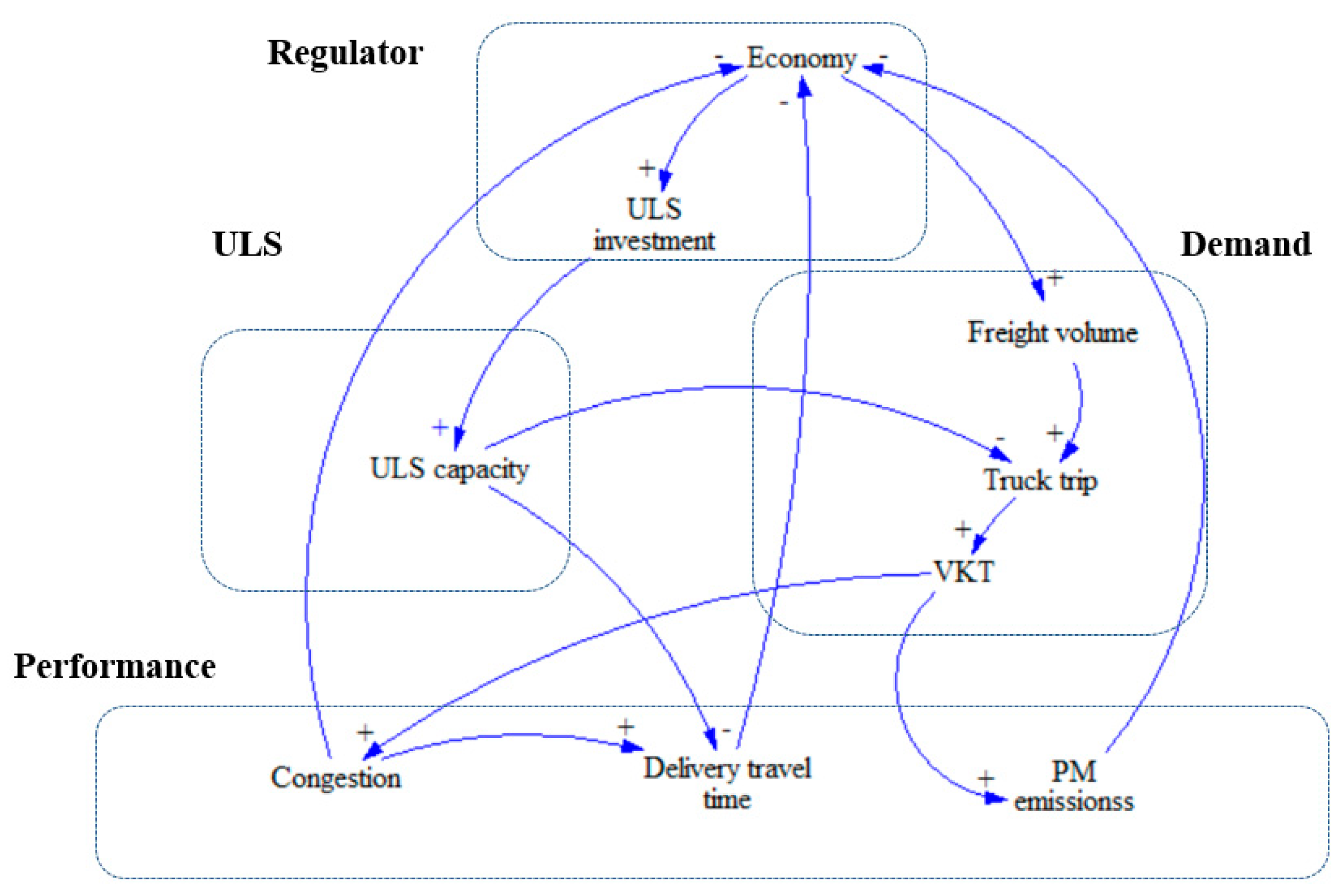


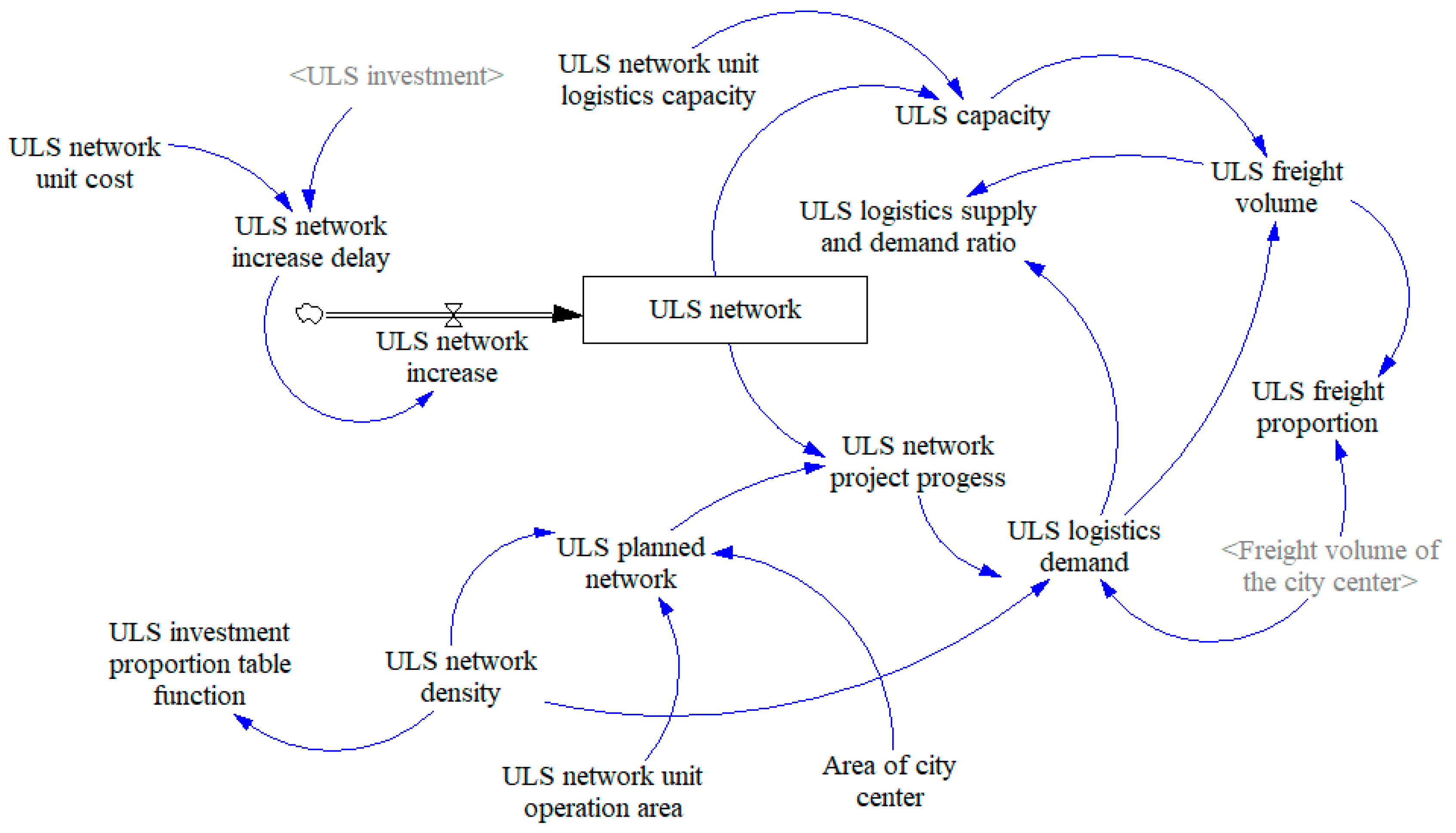


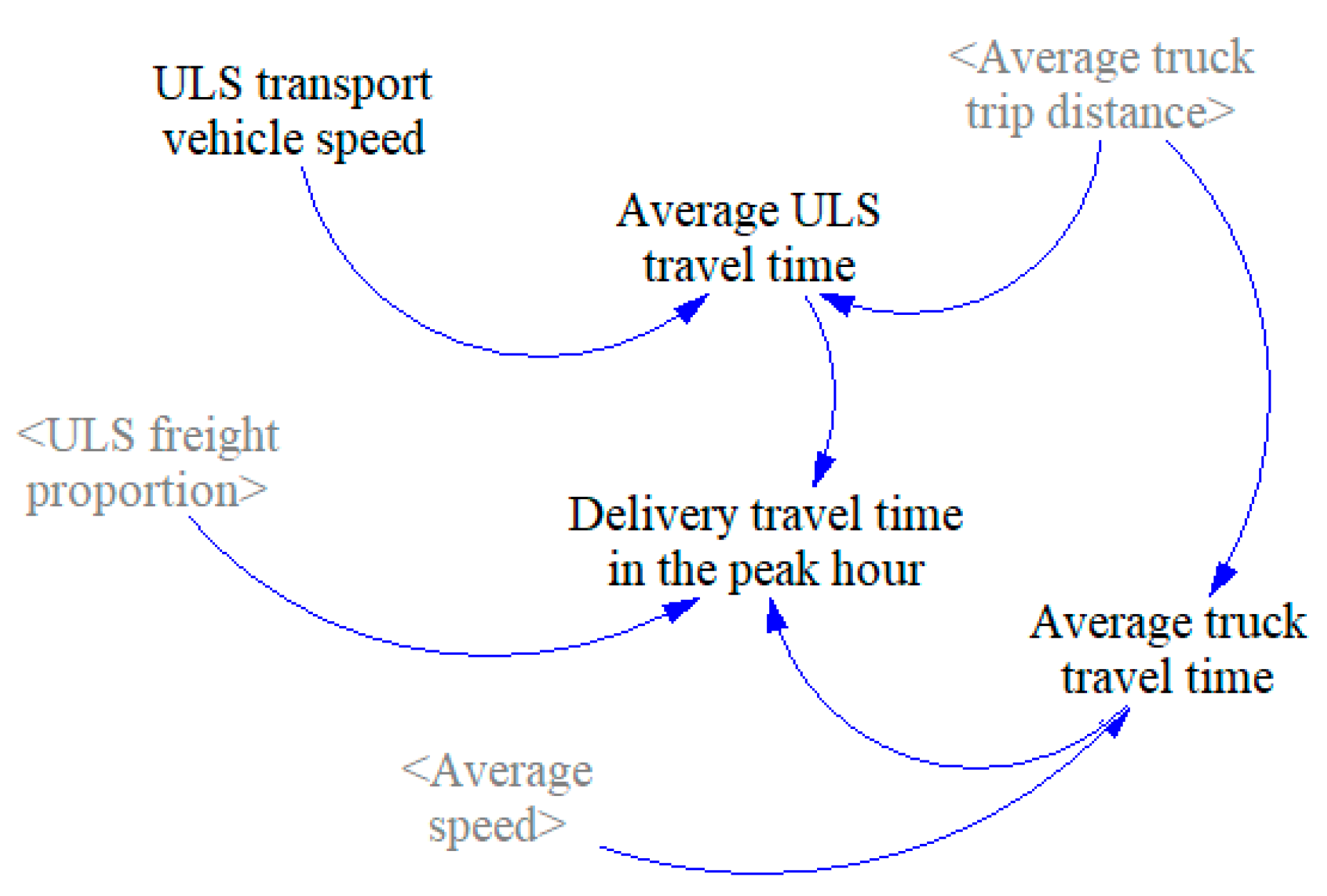



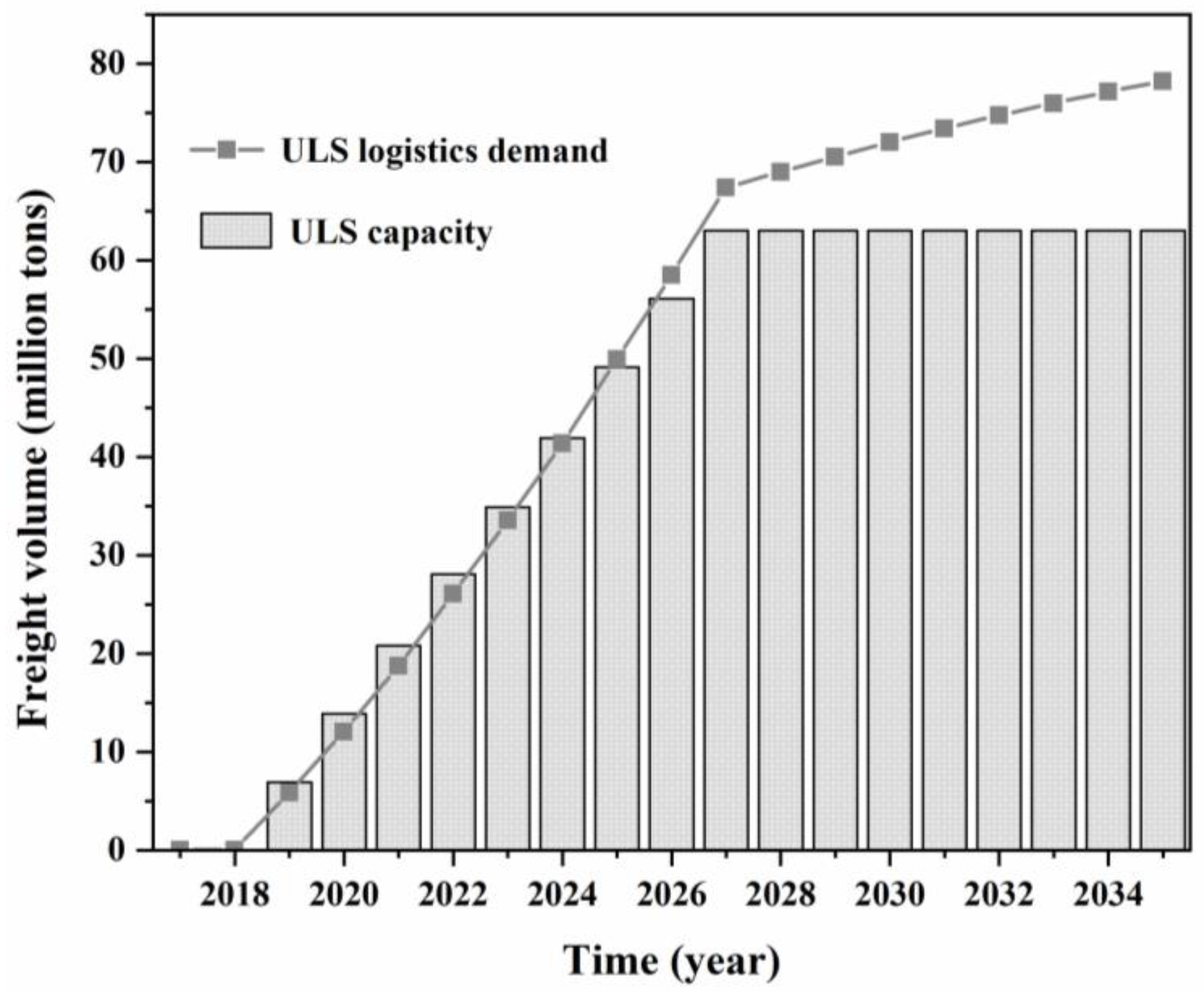
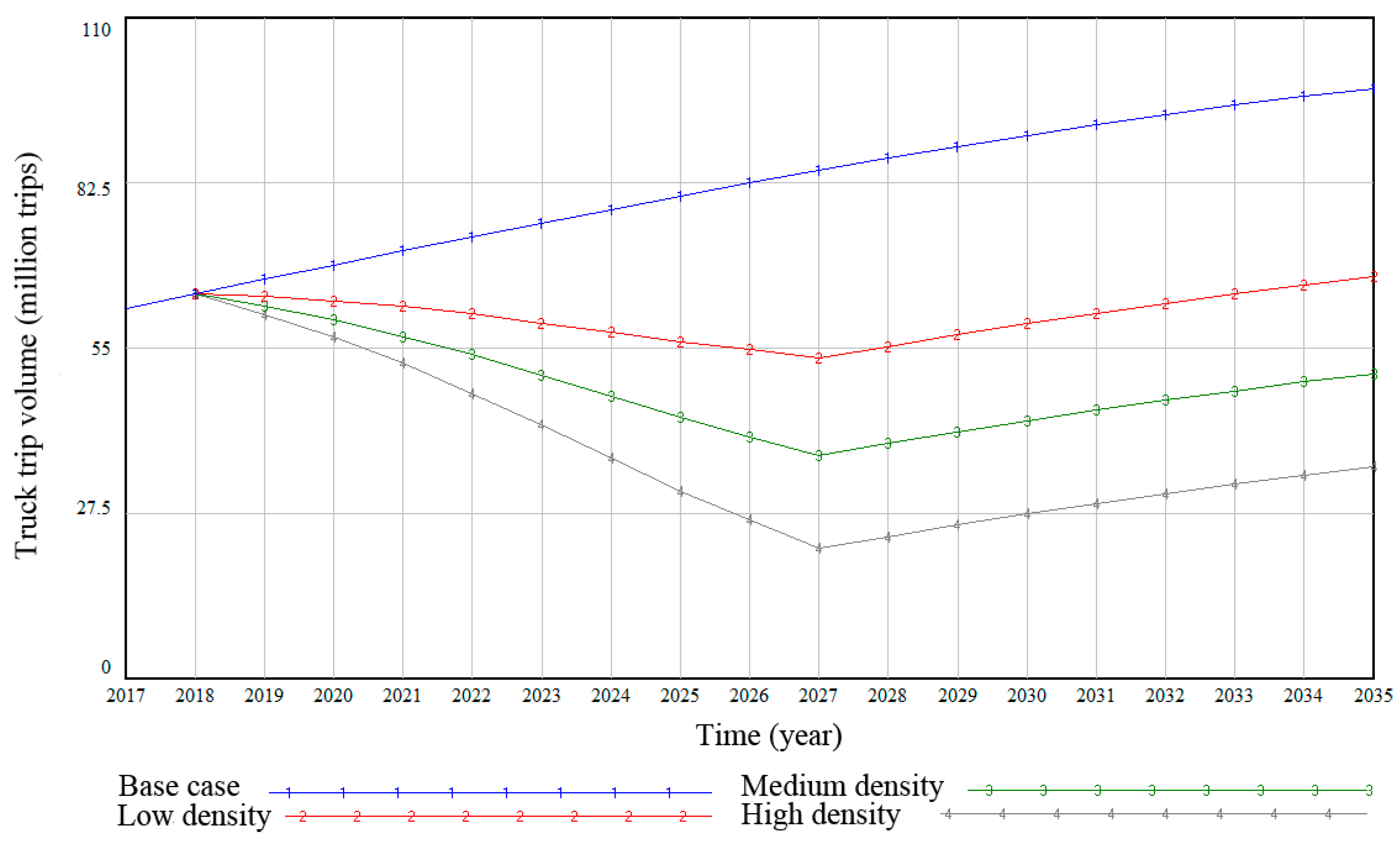
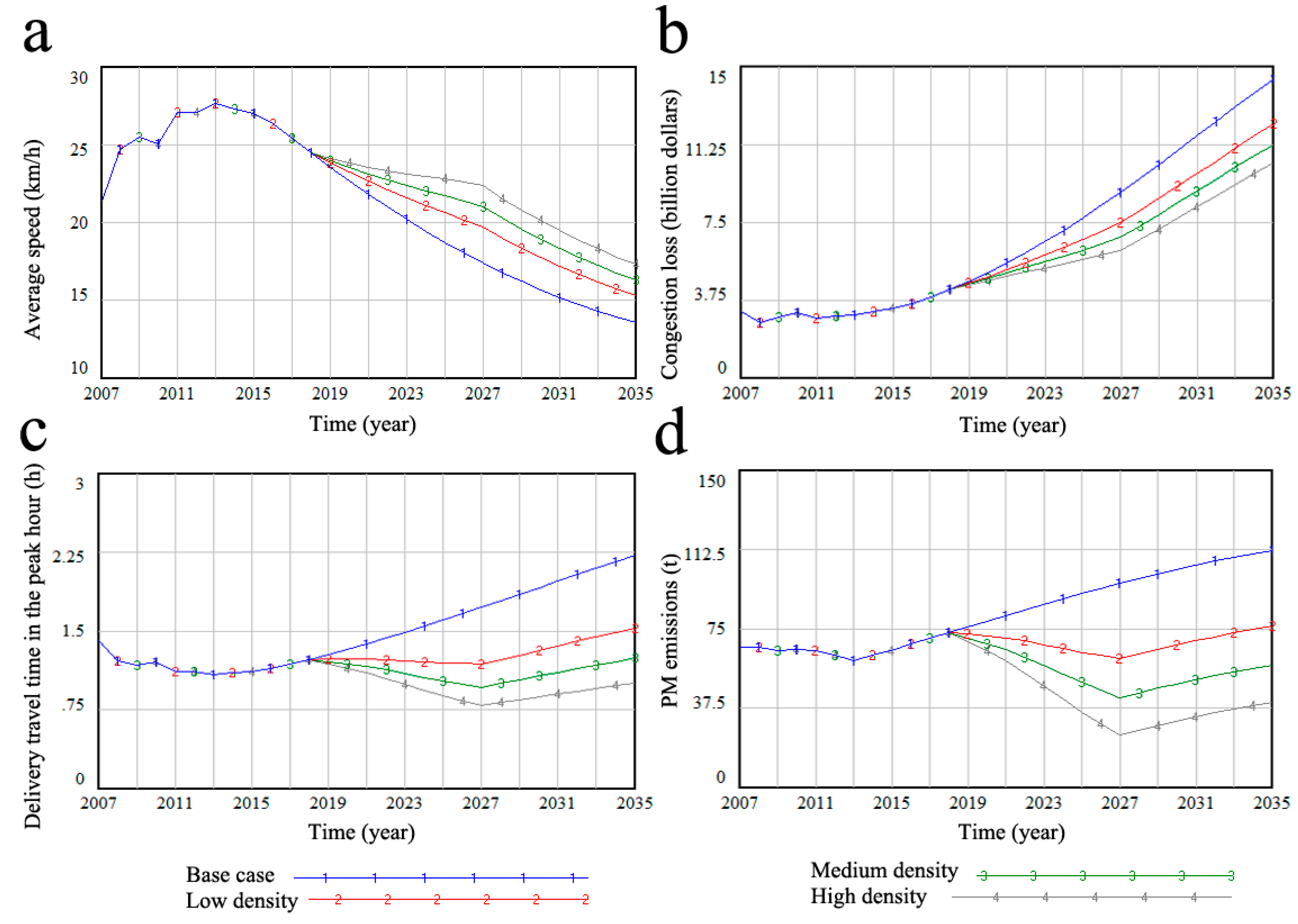
| Category | Variables |
|---|---|
| Reinforcing Loop 1 | Economy→+ULS investment→+ULS capacity→−Truck trip→+VKT→+Congestion→+Delivery travel time→−Economy |
| Reinforcing Loop 2 | Economy→+ULS investment→+ULS capacity→−Truck trip→+VKT→+ PM emissions→−Economy |
| Reinforcing Loop 3 | Economy→+ULS investment→+ULS capacity→−Truck trip→+VKT→+Congestion→−Economy |
| Reinforcing Loop 4 | Economy→+ULS investment→+ULS capacity→−Delivery travel time→−Economy |
| Balancing Loop 1 | Economy→+Freight volume→+Truck trip→+VKT→+Congestion→−Economy |
| Balancing Loop 2 | Economy→+ Freight volume→+Truck trip→+VKT→+PM emissions→−Economy |
| Balancing Loop 3 | Economy→+ Freight volume→+Truck trip→+VKT→+Congestion→+ Delivery travel time→−Economy |
| Notation | Variable | Reference | Notation | Variable | Reference |
|---|---|---|---|---|---|
| UFV | ULS freight volume | [10] | CL | Congestion loss | [47] |
| UC | ULS capability | [10] | ATTT | Average truck travel time | [48] |
| UITF | ULS investment proportion table function | [10] | DTPH | Delivery travel time in the peak hour | [48] |
| UNPP | ULS network project implementation progress | [10] | GDP | GDP | [49] |
| FV | Freight volume of the city | [10] | GDPGR | GDP growth rate | [49] |
| FVCC | Freight volume of the city center | [10] | GDPT | GDP increase | [49] |
| ULD | ULS logistics demand | [10] | TTV | Truck trip volume | [50] |
| UND | ULS network density | [10] | ATTD | Average truck trip distance | [50] |
| AUTT | Average ULS travel time | [10] | TPHF | Truck trip peak hour factor | [50] |
| UFP | ULS freight proportion | [10] | TVCF | Truck vehicle conversion factor | [50] |
| UI | ULS investment | [10] | TI | Traffic intensity | [50] |
| UULC | ULS network unit logistics capacity | [10] | RC | Road capacity | [50] |
| UN | ULS network | [10] | GT | Ground transportation | [50] |
| UR | ULS logistics supply and demand ratio | [10] | AS | Average speed | [50] |
| TT | Truck turnover | [44] | TLI | Transportation and logistics investment | [50] |
| FVRF | Freight volume reduction factor | [44] | VKT | Vehicle kilometers travelled | [50] |
| DT | Delay time | [47] | PME | PM emissions | [51] |
| VPT | Value of person time | [47] | EF | Emission factor | [51] |
| TL | Truck load | [52] |
| Variable | Value/Unit |
|---|---|
| Freight volume reduction factor (FVRF) | 0.211 |
| Truck peak hour factor (TPHF) | 0.2 |
| Value of person time (VPT) | 7.5 dollars/h |
| Truck load (TL) | 1 ton/vehicle |
| Average truck trip distance (ATTD) | 30 km |
| Truck vehicle conversion factor (TVCF) | 3 |
| ULS transport vehicle speed | 50 km/h |
| ULS network unit logistics capacity (UULC) | 0.33 million tons/year |
| ULS network unit operation area | 4 square meters/unit |
| ULS network unit cost | 59.7 million dollars/unit |
| Proportion of private car trip | 0.33 |
| Proportion of taxi trip | 0.06 |
| Proportion of bus trip | 0.27 |
| Private car peak hour factor | 0.2 |
| Taxi peak hour factor | 0.1 |
| Bus peak hour factor | 0.16 |
| Year | 2007 | 2008 | 2009 | 2010 | 2011 | 2012 | 2013 | 2014 | 2015 | 2016 |
|---|---|---|---|---|---|---|---|---|---|---|
| Historical values (million tons) | 17872 | 18689 | 18753 | 20184 | 23276 | 24925 | 24651 | 25416 | 19044 | 19972 |
| Simulated values (million tons) | 17482 | 18608 | 19440 | 20981 | 22537 | 23694 | 24958 | 25954 | 26975 | 28097 |
| Error (%) | 2.2% | 0.4% | 3.7% | 3.9% | 3.2% | 4.9% | 1.2% | 2.1% | 41.6% | 40.6% |
| MAPE (%) | MSE (units2) | UM | US | UC | |
|---|---|---|---|---|---|
| Average speed | 2.5 | 0.57 | 0.08 | 0.09 | 0.83 |
| Variable | BC | LD | MD | HD |
|---|---|---|---|---|
| ULS network density | 0 | 0.4 | 0.6 | 0.8 |
© 2019 by the authors. Licensee MDPI, Basel, Switzerland. This article is an open access article distributed under the terms and conditions of the Creative Commons Attribution (CC BY) license (http://creativecommons.org/licenses/by/4.0/).
Share and Cite
Dong, J.; Xu, Y.; Hwang, B.-g.; Ren, R.; Chen, Z. The Impact of Underground Logistics System on Urban Sustainable Development: A System Dynamics Approach. Sustainability 2019, 11, 1223. https://doi.org/10.3390/su11051223
Dong J, Xu Y, Hwang B-g, Ren R, Chen Z. The Impact of Underground Logistics System on Urban Sustainable Development: A System Dynamics Approach. Sustainability. 2019; 11(5):1223. https://doi.org/10.3390/su11051223
Chicago/Turabian StyleDong, Jianjun, Yuanxian Xu, Bon-gang Hwang, Rui Ren, and Zhilong Chen. 2019. "The Impact of Underground Logistics System on Urban Sustainable Development: A System Dynamics Approach" Sustainability 11, no. 5: 1223. https://doi.org/10.3390/su11051223
APA StyleDong, J., Xu, Y., Hwang, B.-g., Ren, R., & Chen, Z. (2019). The Impact of Underground Logistics System on Urban Sustainable Development: A System Dynamics Approach. Sustainability, 11(5), 1223. https://doi.org/10.3390/su11051223






